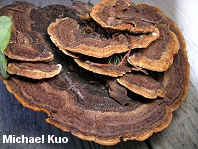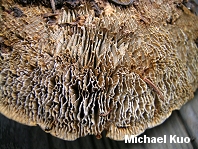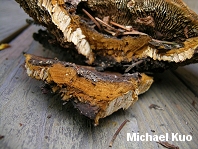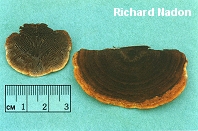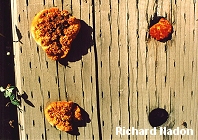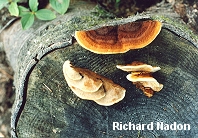| Major Groups > Polypores > Gloeophyllum sepiarium |

|
Gloeophyllum sepiarium [ Basidiomycota > Gloeophyllales > Gloeophyllaceae > Gloeophyllum . . . ] by Michael Kuo Decomposing the deadwood of conifers across North America, Gloeophyllum sepiarium is fairly easily recognized. When fresh and very young its cap is more or less orange, but as it matures brown colors replace the orange from the center outwards. The underside of this polypore features gills--which is a bit odd, since polypores have pores rather than gills! (For help sorting through this mess, see the essay on the page for Lenzites betulinus, another "gilled polypore.") Other distinguishing features include the brown flesh and the black reaction to KOH, as well as microscopic features. Description: Ecology: Saprobic on the deadwood of conifers and, occasionally, hardwoods (especially those, like quaking aspen, that grow in conifer-dominated ecosystems); causing a brown rot; growing alone or gregariously; appearing in woods, but not infrequently found on lumber in urban settings; annual or reviving to be perennial; summer and fall (and over winter in warm climates); widely distributed in North America. Cap: Single or compound (and then either fused laterally or with loosely arranged lobes arising from a central point); up to about 12 cm across and 8 cm deep; semicircular, irregularly bracket-shaped, or kidney-shaped; flattened-convex; velvety to hairy; rugged; with concentric zones of texture and color; at first yellow to orange, becoming yellow-brown to dark brown or nearly black toward the point of attachment but usually remaining yellow to orange on the growing margin. Gills: Irregular and often fusing; fairly close; often mixed with slot-like pores; edges yellow-brown becoming darker brown with age; faces creamy to pale brownish, darkening with age; up to about 1 cm deep. Stem: Absent Flesh: Dark rusty brown or dark yellow-brown; corky. Chemical Reactions: KOH black on flesh. Spore Print: White. Microscopic Features: Spores 9-13 x 3-5 µ; smooth; cylindric; inamyloid; hyaline in KOH. Basidia often elongated. Cystidia cylindric; up to about 100 x 10 µ. Hyphal system trimitic. REFERENCES: (Wulfen, 1786) Karsten, 1882. (Fries, 1821; Saccardo, 1887; Overholts, 1953; Smith, Smith & Weber, 1981; Arora, 1986; Gilbertson & Ryvarden, 1987; States, 1990; Phillips, 1991/2005; Lincoff, 1992; Metzler & Metzler, 1992; Evenson, 1997; Barron, 1999; McNeil, 2006; Miller & Miller, 2006.) Herb. Kuo 08140702; DBG RMNP 2008-087, 2008-091, 2008-096, 2008-097, 2008-098. This website contains no information about the edibility or toxicity of mushrooms. |
© MushroomExpert.Com |
|
Cite this page as: Kuo, M. (2010, February). Gloeophyllum sepiarium. Retrieved from the MushroomExpert.Com Web site: http://www.mushroomexpert.com/gloeophyllum_sepiarium.html |
